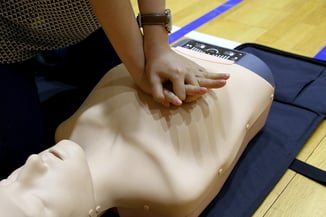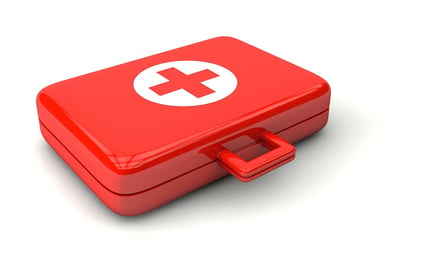Most of us probably know the general basics when it comes to taking care of your horse when he is hurt. But what if you or another rider is injured and/or is left unconscious? Could you recognize the signs of shock, and do you know how to treat it? If you spend a lot of time around horses, then it’s possible that one day you will have to help a rider in a serious situation. Let’s review the First-Aid basics that you will want to know. Dealing with a Fall
If a rider is injured, immediately call 911 and keep him or her still. Do not remove the rider’s helmet. If the rider is bleeding use a clean towel and apply firm pressure on the wound. Do not remove the pressure until medical assistance has arrived. Have another person catch the horse and instruct any other riders to dismount and hold their horses as the ambulance approaches.
 Performing CPR
Performing CPR
If a rider’s heart or breathing has stopped, cardiopulmonary resuscitation (CPR) is necessary to keep the rider’s blood flowing to his or her brain until medical assistance arrives. The American Heart Association recommends that anyone not trained in CPR provide only chest compressions and not attempt rescue breathing.
Before beginning chest compressions, you will want to make sure that the person is not conscious and that there is no heartbeat. Call 911 immediately, then begin chest compressions. To perform chest compressions, lay the person on their back on a firm surface and kneel near their shoulders. Put the heel of one hand in the center of the person’s chest, and put your other hand on top. Using your upper body and keeping your arms straight, push down into the person’s chest firmly – you should be pushing their chest down by about two inches. Repeat the compressions at the rate of 100 compressions per minute and continue until help arrives.
For emergency cardiovascular training, visit the American Heart Association’s website.
Dealing with Shock
A rider can go into shock for any number of reasons, including a traumatic fall, blood loss, and heatstroke. Signs of shock include a weak and rapid pulse; cool, clammy, and pale skin; nausea or vomiting; and the person feeling weak or being confused.
If you believe that a rider is going into shock, immediately call 911 and then have the person lie down. Elevate their feet higher than their head (unless the person is injured – in that case, allow them to lie flat). As you wait for help to arrive, keep the person warm and make sure that they are breathing and that their heart is beating. Monitor them to make sure that they don’t vomit – if they do, you will need to turn them on their side.
In a medical emergency, acting quickly and staying calm is key. Always call 911 immediately. It is also a great idea to take an emergency training course and provide safety tip sheets in your tack room for other riders.
Also, always make sure to have a fully stocked first aid kit available.



